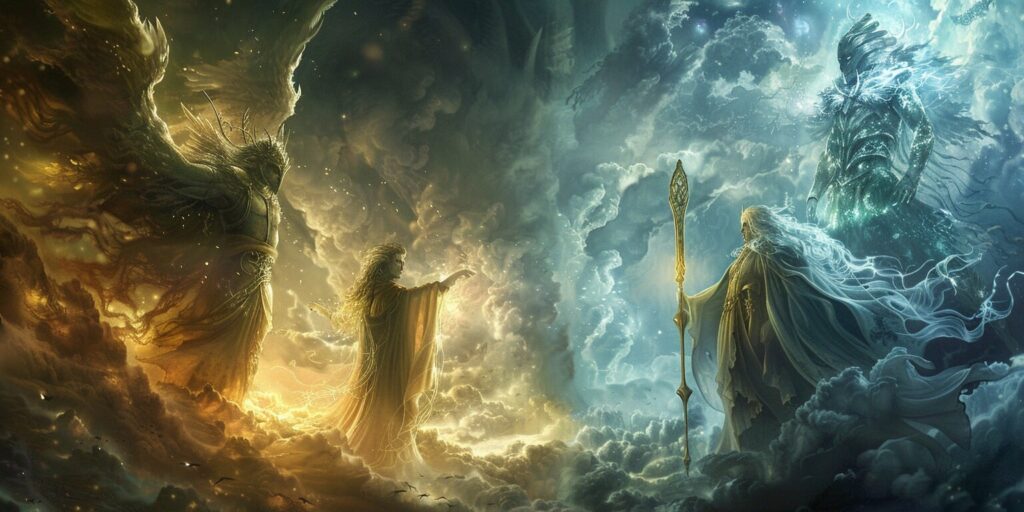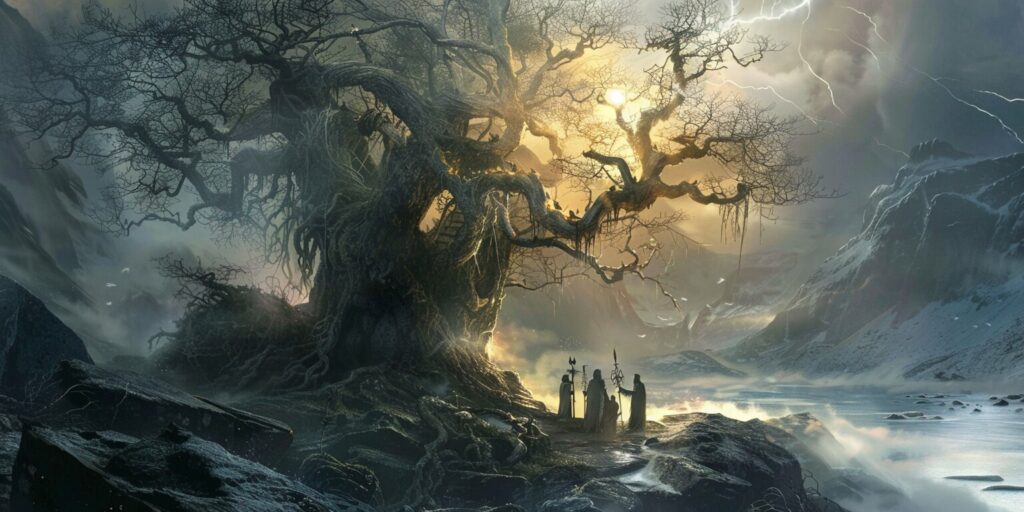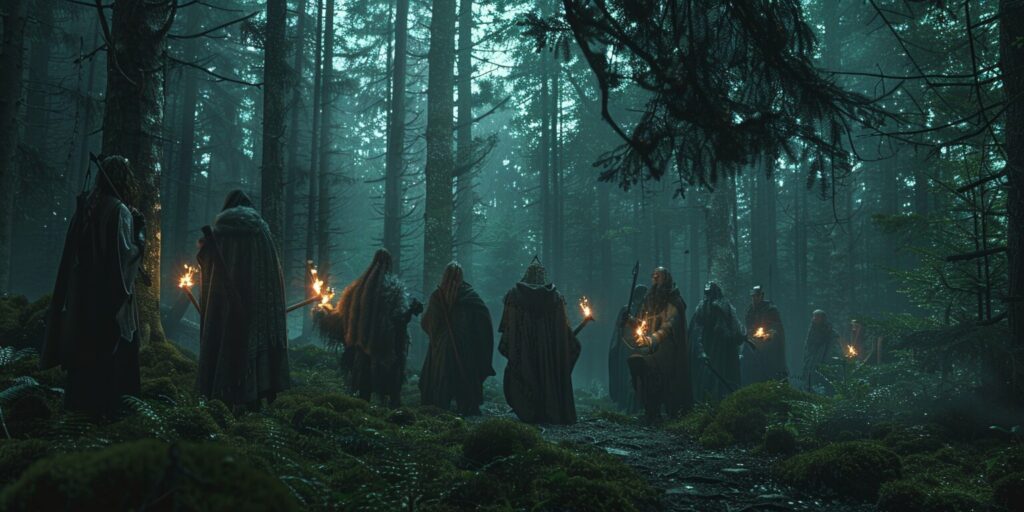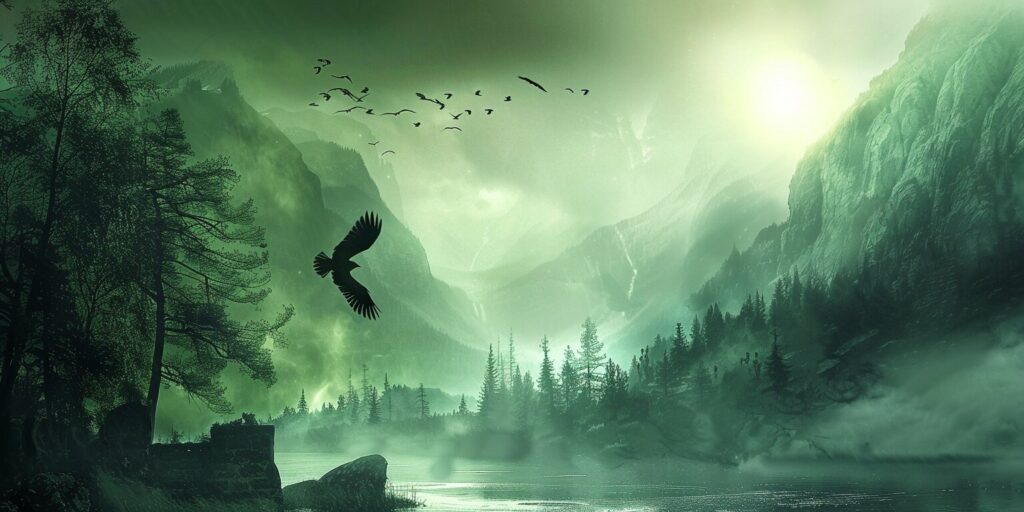Norse Ancestry, Norse Mythology, Viking Heritage
The Modern Resurgence of Norse Paganism: Ancient Beliefs in Today’s World
In the modern era, a growing number of people are drawn to the rich tapestry of Norse paganism, an ancient religious tradition that originated in Northern Europe during the Viking Age and the Pre-Christian era. Also known as Scandinavian paganism or Germanic paganism, this belief system has experienced a remarkable resurgence, with individuals from diverse backgrounds exploring and embracing the Norse pagan beliefs and Norse paganism beliefs of their ancestors, highlighting the importance of the afterlife in Norse society.
At the heart of this revival lies a deep fascination with Norse mythology, the pantheon of gods and goddesses such as Odin and Thor, and the reverence for the natural world and the cycles of seasons practiced by Norse pagans that characterize Norse paganism. As more people seek spiritual connection and a sense of cultural identity, this religion is once again gaining traction, offering a unique and authentic path for those drawn to the Norse pagan and Norse religious traditions.
What is Norse Paganism and Its Relevance Today?
Norse paganism, also known as Scandinavian or Germanic paganism, is an ancient religious tradition rooted in the Northern European cultures of the Viking Age and pre-Christian era. At the heart of this belief system is the worship of a diverse pantheon of gods and goddesses and a deep reverence for the natural world and the cyclical nature of the seasons, which are central aspects of the old way and religious practices.
Exploring the Origins and Basics of Norse Paganism
The origins of Norse paganism, or the Old Norse religion, can be traced back to the pre-Christian societies of Scandinavia, Iceland, and other parts of Northern Europe, where Vikings held sway. These ancient belief systems were centered around the veneration of deities such as Odin, the “All-Father” associated with wisdom, war, and the dead; Thor, the god of thunder, storms, and protection; and Freyr and Freyja, the twin deities of fertility, love, and prosperity. Norse pagans also placed great importance on the natural world, honoring the landvættir (land spirits) and celebrating seasonal festivals to mark the changing of the seasons.
Significance of Norse Paganism in Modern Spirituality
In recent decades, there has been a growing interest in and resurgence of Norse paganism, with more people drawn to the rich mythology, nature-based spirituality, and emphasis on the ancestral connection that characterizes this ancient belief system. For many modern Norse pagans, the practice of this religion is not just about honoring the gods and goddesses but also about reconnecting with the natural world, cultivating a sense of community, and exploring their own personal spiritual journey.
The Connection Between Contemporary Practices and Ancient Norse Beliefs
While modern Norse paganism has evolved and adapted to the present-day context, there are still strong ties between contemporary practices and the ancient beliefs and rituals of the pre-Christian era, indicating a revived interest in Norse mythology. Many Norse pagans today incorporate traditional elements such as the use of runes, the celebration of seasonal festivals, and the veneration of the gods and goddesses, all essential practices of heathenry, into their spiritual routines. This connection to the past serves to reinforce the sense of cultural continuity and the ongoing relevance of Norse paganism in the modern world.
Understanding Norse Deities in Pagan Beliefs
At the heart of Norse paganism is a rich and diverse pantheon of Norse gods and goddesses, each with their own unique domains, personalities, and mythological stories. The most well-known of these deities are Odin, the “All-Father,” who is associated with wisdom, war, and the dead; Thor, the god of thunder, storms, and protection; and Freyr and Freyja, the twin deities of fertility, love, and prosperity.
Exploring the Pantheon of Norse Gods and Goddesses
The Norse pantheon is intricately detailed, featuring a multitude of gods and goddesses, each ruling over specific aspects of life and nature. Odin, the chief of the Aesir, is revered for his wisdom and shrewdness in warfare and diplomacy. His son, Thor, symbolizes strength and protection, wielding his mighty hammer, Mjölnir, to control the weather and combat his foes, the giants. Freyja, one of the most venerated Vanir goddesses, rules over love, beauty, and fertility, highlighting the Norse culture’s appreciation for the vital forces of life. Although not always malevolent, Loki, the trickster god, plays a crucial role in many myths, demonstrating the Norse value of cunning and adaptability in the face of adversity.

Norse Mythology: Stories and Legends of Odin, Thor, and Other Deities
Norse mythology brims with enthralling tales where gods interact with each other and the world. In a perpetual quest for knowledge, Odin sacrifices his eye at the well of Mimir, gaining immense wisdom at a personal cost. Thor’s numerous quests to thwart giants underline his role as a protector of Asgard and Midgard (the human world), embodying the virtues of strength and valor. The stories often convey moral lessons, such as the importance of bravery, wisdom, loyalty, and respect for nature, which were cornerstone values in Viking society.
Rituals and Sacrifices: How Norse Pagans Honor Their Deities
Rituals and sacrifices were vital in Norse paganism, reflecting deep respect and dependence on the divine. The Blót, an essential communal ritual, involved offerings of food, drink, and sometimes animals or human beings to gods like Odin for warfare, Thor for weather and crops, and Freyja for fertility and prosperity. These ceremonies, held at significant times like changing seasons, were pivotal in seeking divine favor and ensuring community welfare. Seers or priests, often powerful figures within communities, conducted these elaborate rituals, emphasizing the strong ties between the community, its survival, and its beliefs. Through these practices, Norse pagans sought to maintain harmony with the natural and supernatural worlds, a testament to their profound connection with their environment and deities.
The Practice of Norse Rituals and Ceremonies
The practice of Norse paganism is heavily rooted in traditional Norse rituals and ceremonies, which serve to honor the gods and goddesses, connect with the natural world, and maintain a sense of community and cultural continuity. These Norse pagan rituals and celebrations are an integral part of the modern pagan practices of those who practice Norse paganism.
Traditional Norse Rituals and Their Role in Modern Pagan Practices
Traditional Norse rituals, deeply rooted in the historical practices of the Vikings, continue to influence modern pagan practices, particularly those of Asatru and other forms of Heathenry. These rituals, rich with symbolism and reverence for the natural world, connect contemporary practitioners to their ancient heritage.
Central to traditional Norse rituals is the Blót, an offering ceremony where participants give gifts of food, drink, and sometimes symbolic objects to the land’s gods, ancestors, and spirits. This practice, which historically could include animal sacrifice, is now often represented by more symbolic offerings like mead, bread, or crafted items, reflecting an adaptation to modern sensibilities while maintaining the ritual’s core intent of honoring and seeking favor from the divine.
Another key ritual is the Sumbel, a ceremonial toast that involves passing a drinking horn among participants, each of whom may offer a toast, boast, or oath. This strengthens communal bonds and allows individuals to voice their commitments and aspirations within the safety of a supportive group setting.
These rituals preserve the cultural and religious practices of Norse ancestors and provide a framework for community building and personal spiritual development in modern contexts. Modern Heathens find both a link to their past and a relevant expression of their faith in today’s world through these revived practices.

Seasonal Festivals and Celebrations in Norse Paganism
Norse pagans celebrate a variety of seasonal festivals throughout the year, each marking the changing cycles and seasons, embodying the religious practices of the ancient culture. From the winter solstice to the summer solstice, these celebrations in Norse paganism are opportunities to gather, honor the landvættir (protective spirits of the land), and participate in rituals and feasts that connect the community to the rhythms of the natural world.
The Importance of Runes and Symbols in Norse Rituals
Runes and other symbolic elements play a crucial role in Norse pagan rituals and ceremonies. These ancient Norse symbols are believed to possess inherent power and are used for divination, meditation, and the invocation of the Norse gods and goddesses. The careful incorporation of runes and symbols into Norse rituals helps Norse pagans deepen their connection to the traditions and beliefs of their ancestors.
Norse Pagan Beliefs and Cosmology
At the heart of Norse pagan beliefs is a complex and multifaceted worldview encompassing a rich cosmology, a pantheon of deities, and a deep reverence for the natural world and life cycles. The Norse pagan beliefs and practices reflect the cultural and spiritual traditions of the Norse people, who inhabited the Nordic and pre-Christian Scandinavian regions for centuries and were deeply rooted in the pre-Christian religion.
Exploring the Belief System and Worldview of Norse Pagans
The Norse pagan beliefs are grounded in the idea of a dynamic and interconnected universe, where the gods and goddesses of the Norse pantheon play a central role in shaping the world and the lives of Germanic and Nordic people. These deities are believed to possess diverse domains, personalities, and mythological stories, representing various aspects of the natural and spiritual realms.

Norse Cosmology: Understanding the Norse Concept of the Universe
The Norse cosmology, a pivotal aspect of the Old Norse religion, depicts a complex and multilayered universe, with the World Tree, Yggdrasil, at its center and realms such as Valhalla and Hel woven into its branches. This cosmic tree is believed to connect the different realms of existence, including the realm of the gods, the realm of the dead, and the realm of mortals. The Norse pagan beliefs often involve the reverence of this world tree and the associated deities and spirits, such as the Vanir and the landvættir, or land spirits.
Connection Between Norse Pagan Beliefs and Ancestral Practices
The Old Norse religion, deeply rooted in reverence for ancestors and the understanding of the continuity between the living and the dead, also reflects Norse pagans’ belief in the interconnectedness of all beings. Many Norse pagan rituals and celebrations, such as seasonal festivals and gatherings around the altar, are designed to honor the deities and connect with the spiritual world of the ancestors. This ancestral connection is a vital aspect of the Norse pagan spirituality and the modern resurgence of Norse paganism.
Conclusion
The modern resurgence of Norse paganism is a testament to this ancient religious tradition’s enduring power and relevance. As more people worldwide are drawn to the rich mythology, nature-based spirituality, and the emphasis on the ancestral connection that characterizes Norse paganism, this belief system is gaining traction and influence again.
From the pantheon of gods and goddesses like Odin, Thor, Freyr, and Freyja to the intricate Norse cosmology and the reverence for the natural world, the core elements of Norse pagan beliefs continue to captivate and inspire a growing number of practitioners. Whether through the performance of traditional rituals and ceremonies, the exploration of runes and symbols, or the celebration of seasonal festivals, the Norse pagan community is actively preserving and revitalizing this ancient faith.
As the world becomes increasingly complex and disconnected, the Norse pagan emphasis on community, spirituality, and connection to one’s ancestral roots offers a compelling alternative to the dominant religious and cultural narratives. Norse paganism provides a means of exploring one’s Germanic heritage and pre-Christian roots and presents a holistic worldview that resonates with those seeking a more nature-based and spiritually fulfilling way of life.

